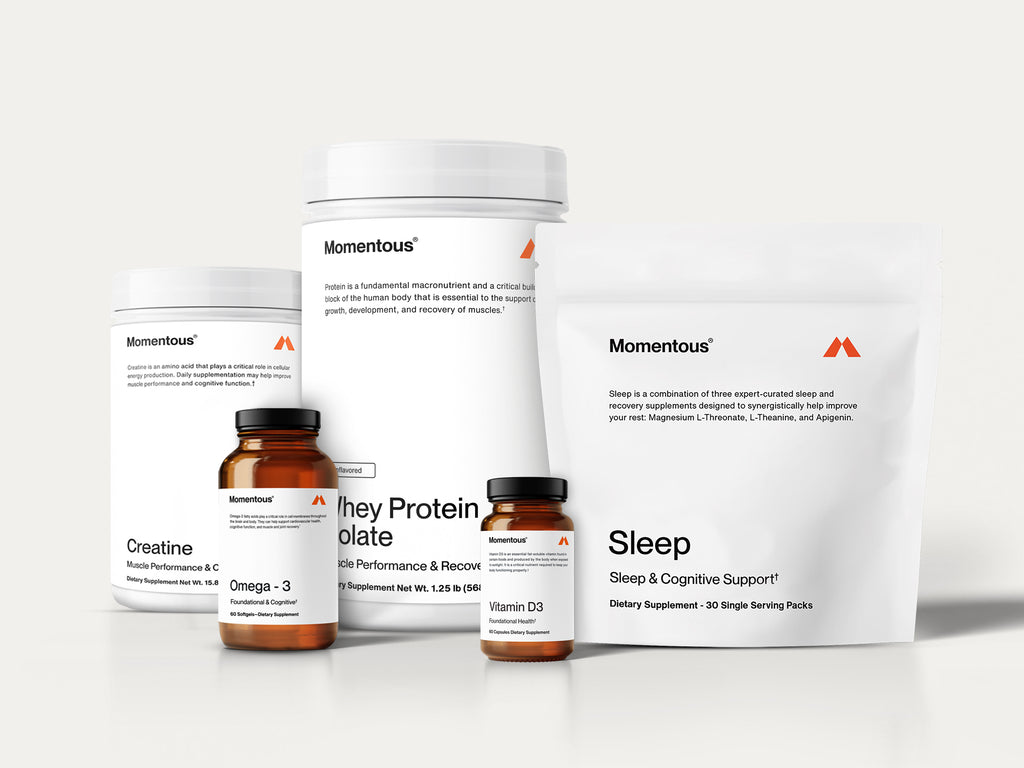Choline source that supports memory, focus + brain health
Daily nootropic blend for clarity, productivity + cognitive function
Whole-food–based formula to fill nutrient gaps for daily health
If you’re a runner, cyclist, or triathlete, one of the easiest ways to become more resilient and powerful is to add resistance training into your routine. Yet for several reasons, many endurance athletes shy away from this, and as such, leave a lot of potential on the table. We caught up with Momentous ambassador and running coach Mary Johnson to talk about her own training journey, the benefits of strength training, how to balance resistance and endurance work, and more.
Why did you start strength training?
Before I was pregnant, I started getting terrible back pain. I got a few cortisone injections and they worked for a while, but once I got to a certain point in my pregnancy, the pain came back. Postpartum, I went to my doctor and asked if I could get another injection. I was really mad when he told me I needed to get stronger and see a physical therapist, but once I’d been strength training for just a couple of weeks, he proved to be right. It sounds like a cliché, but strength training really changed my life for the better.
Other than helping overcome back pain, what are some ways that resistance work can benefit endurance athletes?
I have a client whose leg bones looked translucent on her scans because her bone density was too low. After she’d been strength training consistently two or three times a week for several months, those same bones became opaque. You could literally see the increase in bone density. So this shows you how the load bearing involved in resistance training can reduce the risk of stress fractures and other bone injuries.
Another big one is increasing the durability of ligaments, tendons, and joints. We usually think about the impact of strength work on muscles, but it also makes connective tissues more resilient and injury-resistant. While running is what will make you faster, strength training will help you become a more well-rounded and adaptable athlete.
Having a two-year-old at home and a thriving business, how have you fit strength training into your routine?
In the fall, I was doing 14 days of training and then taking a rest day. As you mentioned, I have a toddler, which meant that I was only getting seven or eight hours of sleep a night versus the eight or nine I’d rather get and wasn’t able to take naps. I think that’s the main reason I got hurt. But because I’ve come to realize how essential resistance training is, I like to do two longer sessions a week when running is the focus. Usually, I’ll double up and do a lifting session and a run on one day, which means I’m training five days a week on average rather than the six that some endurance athletes swear by.
Where do you recommend that endurance athletes begin with resistance workouts?
It depends on your training age, how much time you have available, and what you’re willing to sacrifice to reach your goals. Another key question to continually ask yourself – not just with strength work but with everything in training and life is, “Can I sustain this?” It’s all very well to have ambitious goals, but you need to think about how pursuing them is going to impact your lifestyle and whether you can or should keep going mentally and physically.
With all that being said, I think that a novice could benefit from three strength training sessions a week to begin with, and drop this down to two when they move into a more endurance-focused block.
Are there any words of caution you’d give to an endurance athlete who’s beginning to add strength training into their routine?
Yes. I think that a common mistake is to just layer more on top of what you’re already doing. Some people can handle that kind of additional load, but many can’t and end up getting hurt or dealing with neurological fatigue, which is something I’ve struggled with at times. Runners, cyclists, and other endurance athletes are often all about total distance, but you might have to cut back a little bit on this front.
One of the challenges in doing so is more mental than physical. It’s hard for runners to just lift weights on a certain day and not think of it as being less productive than a day on which they do a hard run. It’s important to frame strength training correctly before you begin so that you approach it with the right frame of mind. To me, it’s not just one more thing to do but an essential part of my running and my life.
What movement patterns are best for endurance athletes to work on in the gym?
I like to do a bit of everything, but I’d say the essential five moments are hinging, squatting, carrying, pushing/pressing, and pulling. If you’re really pushed for time, you could just focus on the first three on this list and get a lot of bang for your buck. I have several clients who are primarily hinging, squatting, and carrying twice a week and are seeing great results.
How important is it to pair nutrition with strength training?
Regardless of how you train endurance or strength, recovery is where the adaptation and progression take place. So sleep and nutrition are absolute must-haves. When I started working with a nutritionist, I realized that I needed to add more carbs and protein to my diet, and when I did so, it made a big difference in my performance and how I felt day to day.
With my clients, I point them toward the American College of Sports Medicine’s macronutrient guidelines. Then I suggest they do a little simple math and see where they’re at in comparison to these numbers. Next, I give them a list of nutritionists and dieticians who I trust. This way, they can get their nutrition on point so that it supports both endurance and strength training.
Where do supplements fit in?
A high percentage of endurance athletes aren’t getting enough protein, so taking something like Momentous Recovery after a workout and a serving or two of Momentous Essential throughout the day can help. A lot of people are interested in collagen, and while I recommend Momentous Collagen Peptides, I think it’s important to first make sure you’re getting enough protein. I’ve also found that creatine has helped speed my recovery from runs and lifting sessions.














